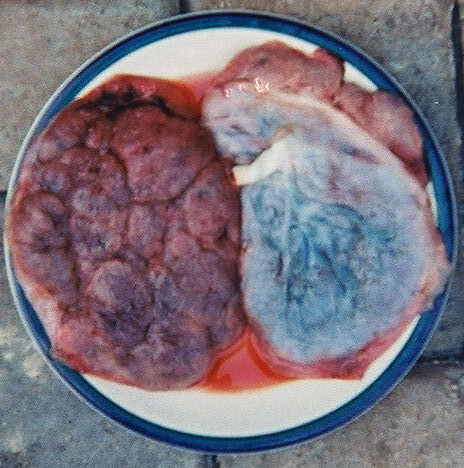Playlist
Show Playlist
Hide Playlist
Placenta: Blood Flow, Barriers & Exchange
-
Slides Conception Pregnancy Endocrine System.pdf
-
Download Lecture Overview
00:00 The Placenta. Let's talk a little bit more about how the placenta and its roles in helping this fetus develop. The placenta abides an attachment point. The placenta will also provide nutrients and removal of waste as well as be an endocrine organ for both the mom as well as for the fetus. You can see what the placenta normally looks like. The placenta though will develop and eventually erode many of these spiral arteries. As spiral arteries erode, you'll start to get wider and wider vesicles. These wide vesicles are much harder to control the blood flow through. So, initially you were able to control blood flow and then as these vessels widen it becomes more difficult. So how does this affect the overall circulation for both the fetus as well as for the mother? In terms of perfusion pressure, the most important thing across the vascular bed is looking at the arterial pressure minus the venous pressure. We term that perfusion pressure. So this is important for placental blood flow. If you now have removed the ability to alter resistance, you now have basically an open tube and as you have an open tube you can no longer regulate flow. Therefore, if we would to plot this with having arterial pressure on the X axis, having arterial flow on the Y, as you now increase arterial pressure you will get more flow. You do not have an ability to alter that flow because those spiral arteries are no longer serving as resistance vessels, they now have little to no resistance. Because they have been widened, luminal areas have been increased. What effect does this have on the mother's blood flow? It first affects blood flow by needing to engorge the placenta with blood and be able to perfuse it with enough blood and be able to regulate how that blood is flowed through the particular placenta. What do I mean about how it flows through the placenta? There is a barrier that is between the mother's blood and the fetus's blood. So as blood flow travels in, it might go through these finger-like projections even to capillaries and then go back out but it never actually touches the fetus's blood. It just gets in a very close proximity. This close proximity about 5 microns is close enough to get exchanges of many of the substances that the fetus needs. Things like oxygen, it can deliver oxygen from the mother's blood to the fetus's. Carbon dioxide can move from the fetus to the mother's blood. You can have exchange of water, you can also have other waste products be given up from the fetus's blood to the mother's. Then there's delivery of important nutrients. Things like you need to have glucose, you need to have vitamins, you need to have amino acids because the fetus will be growing and will need to develop and make new proteins. There also can be some sharing of endocrine responses or hormones across this barrier. The final thing is antibodies are delivered from the mother's blood to the fetus's.
About the Lecture
The lecture Placenta: Blood Flow, Barriers & Exchange by Thad Wilson, PhD is from the course Reproductive Physiology.
Included Quiz Questions
What is the blood pressure at the placental vascular interface during weeks 15-20 of gestation?
- 70 mm Hg
- 50 mm Hg
- 60 mm Hg
- 100 mm Hg
- 120 mm Hg
What is the perfusion pressure at the placenta?
- Arterial - venous pressure
- Osmotic pressure
- Oncotic pressure
- Venous - Arterial pressure
- Venous + Arterial pressure
What is the CORRECT distance between the lumen of maternal blood vessels and of placental blood vessels in microns?
- 5
- 2
- 3
- 4
- 6
Customer reviews
2,0 of 5 stars
| 5 Stars |
|
0 |
| 4 Stars |
|
0 |
| 3 Stars |
|
0 |
| 2 Stars |
|
1 |
| 1 Star |
|
0 |
Although the lecture content is good. This speaker frequently uses inappropriate sentence structure and phrasing. The result is certain sentences, when spoken, become confusing even though their content is simple. For example...Lets talk about how the placenta and its roles in helping the fetus develop. The sentence makes sense when you read it in the script without having listened to it. However, in the mini-lecture, it was read without pauses or breaks that clarified the emphasis of the sentence. it should have been read as: For example...Lets talk about how the placenta, and its roles in helping the fetus, develop. I know the speaker is likely reading a script, but it happens frequently where his enunciation or sentence delivery does not match the context of sentence. This adds a certain layer of listener confusion which delays the rate at which an individual is progressing through each mini-lecture (4-min lecture becomes 7-minutes). This happens frequently with this speaker and is not a huge deal, until you are forced to listen to all of the physiology lectures, and then become agitated.





